
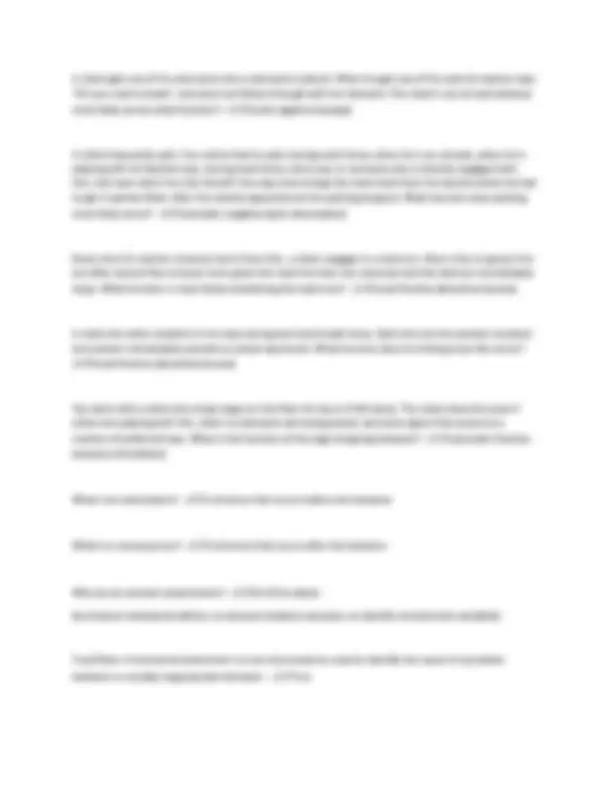

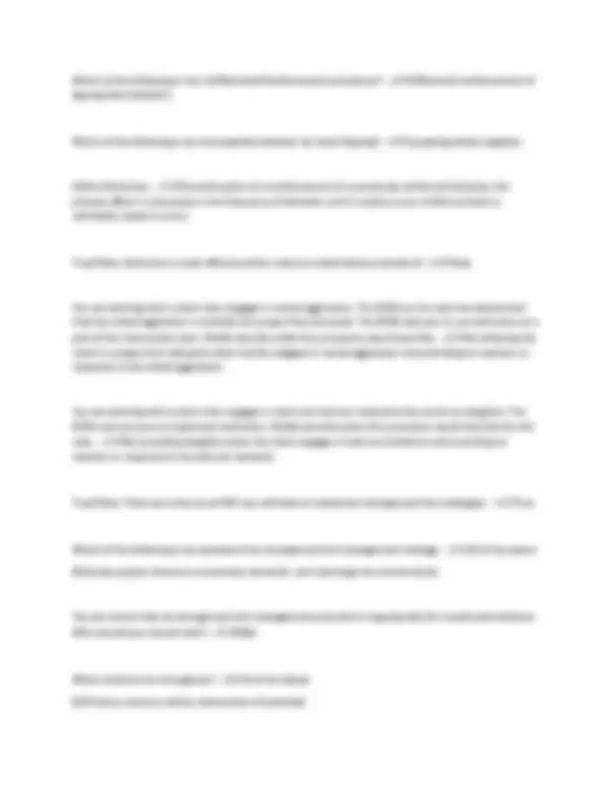
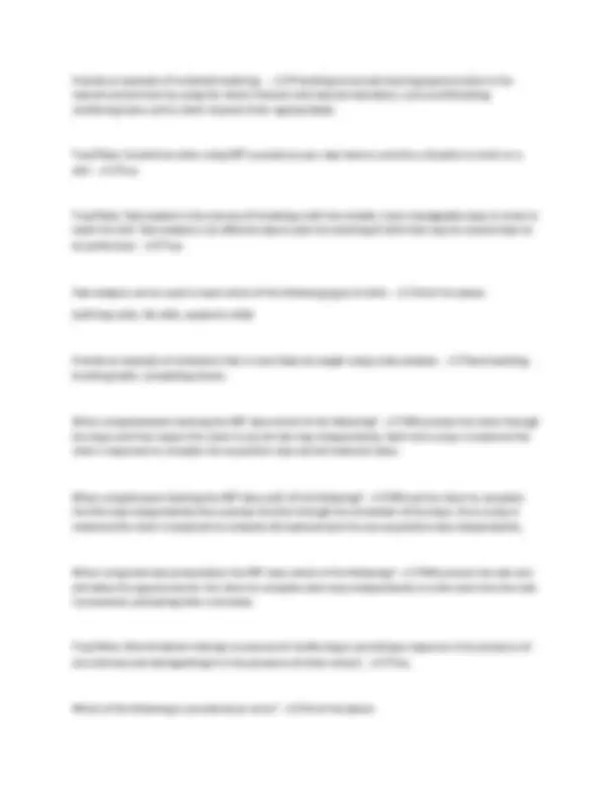
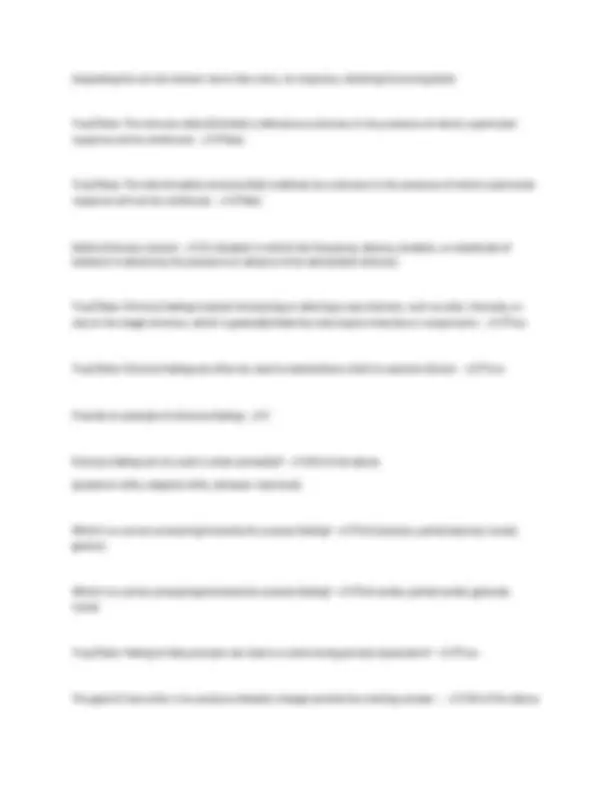
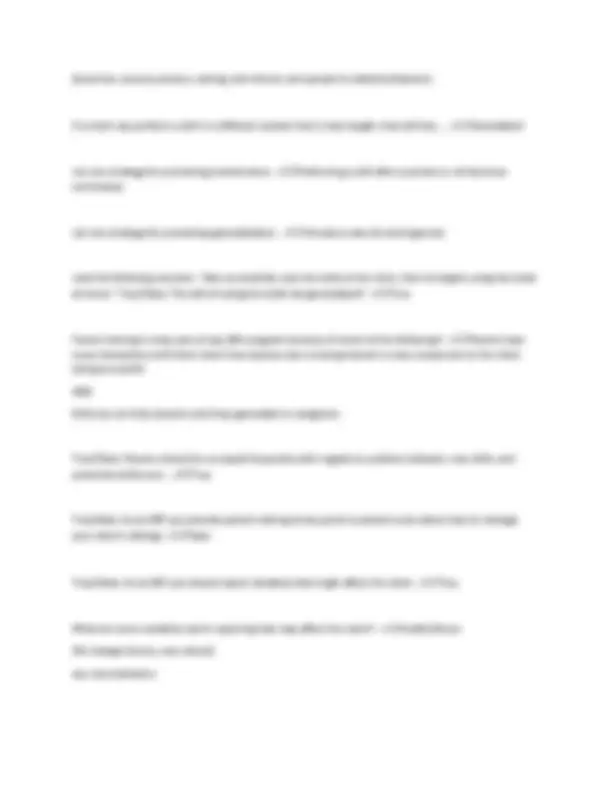
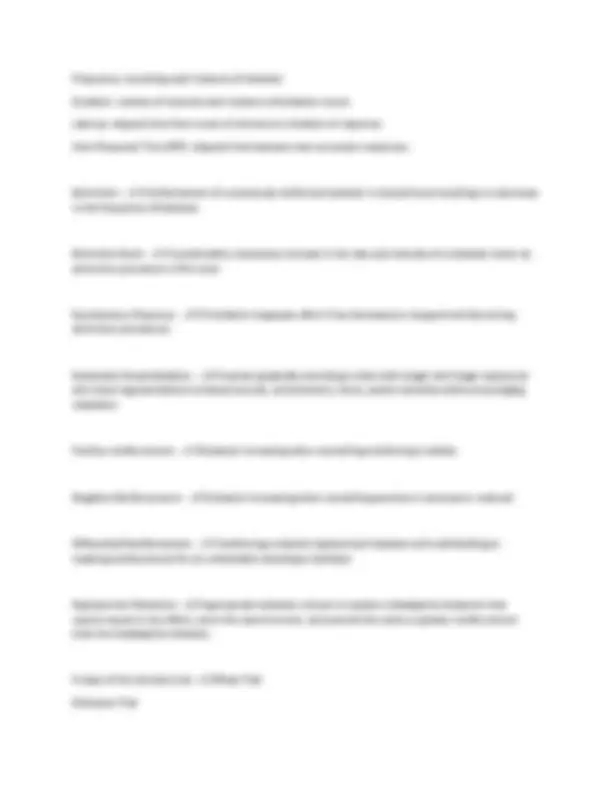
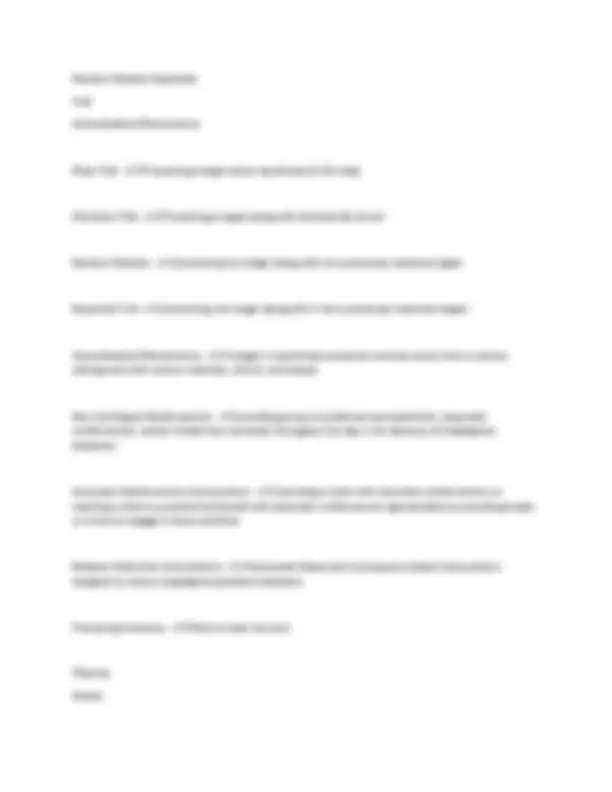



Study with the several resources on Docsity

Earn points by helping other students or get them with a premium plan


Prepare for your exams
Study with the several resources on Docsity

Earn points to download
Earn points by helping other students or get them with a premium plan
Community
Ask the community for help and clear up your study doubts
Discover the best universities in your country according to Docsity users
Free resources
Download our free guides on studying techniques, anxiety management strategies, and thesis advice from Docsity tutors
The roles and responsibilities of the RBT include which of the following? - ✔✔All of the above (deliver discrete trial instruction and incidental teaching, record data, and implement behavior interventions plans as written as a BCBA)
Typology: Exams
1 / 16

This page cannot be seen from the preview
Don't miss anything!










The roles and responsibilities of the RBT include which of the following? - ✔✔All of the above (deliver discrete trial instruction and incidental teaching, record data, and implement behavior interventions plans as written as a BCBA) True/False: An RBT can practice independently of a BCBA - ✔✔False Rate is... - ✔✔the total count per a unit of time Duration is... - ✔✔the time from when the behavior begins to when it ends. Latency is... - ✔✔the time between the presentation of a stimulus and the occurrence of a behavior Which of the following is a continuous recording method? - ✔✔All of the above (duration, rate/frequency, and latency) calculate frequency/rate per hour and minute for a behavior that occurred 120 times over a 2 hour observation - ✔✔ 60 per hour, 1 per minute partial-interval recording is... - ✔✔When the behavior must occur at least once during the interval to be recorded Whole-interval recording is.... - ✔✔when the behavior must occur for the entire interval to be recorded. Momentary time sampling is.... - ✔✔when the behavior must be occurring at the end of the interval to be recorded.
Inter-response time is... - ✔✔The time between the end of one instance of the behavior and the beginning of the next occurrence of behavior. which recording method would you expect to use when a target behavior is set to increase? - ✔✔whole- interval recording Which recording method would you expect to use when a target behavior is set to decrease? - ✔✔Partial-interval recording true or false? Partial interval recording has the tendency to under-estimate the frequency of a target behavior while whole interval recording has the tendency to over-estimate the frequency of the target behavior? - ✔✔False Which of the following are examples of "permanent products" that can be used to collect data using permanent product recording procedures. - ✔✔Number of broken windows and folded shirts True/False: permanent product recording is one of the lease cumbersome data recording methods - ✔✔True Choose the best operational definition for a tantrum - ✔✔Any instance of the client crying and hitting himself in the head with a closed fist which makes a sound that can be heard within five feet. Instance must last longer than 30 seconds and are separated by 30 seconds of non-occurrence. Define behavior: - ✔✔The activity of living organisms; human behavior includes everything that people do. define environment: - ✔✔the conglomerate of real circumstances in which the organism or references part of the organism exists; behavior cannot occur in the absence of environment. List the four functions of behavior: - ✔✔Social positive (attention/access), Social negative (escaping), Automatic Positive (sensory stimulation), Automatic Negative (pain attenuation)
A functional analysis is... - ✔✔The deliberate manipulation of variables to evoke a target behavior to determine the function of the behavior. A Functional Behavior Assessment is... - ✔✔all of the above (a set of interviews conducted to identify the function of a behavior, observations of the problem behavior as it is occurring in the natural setting, and functional analysis) What does the ABC stand for in ABC recording? - ✔✔Antecedent, Behavior, Consequence A reinforcer is... - ✔✔A stimulus that increases or maintains the frequency of a behavior A punisher is... - ✔✔A stimulus that decreases the future frequency of a behavior. Provide one example of a primary reinforcer - ✔✔food, water, warmth. Provide one example of a secondary reinforcer - ✔✔bell, token, praise. The manipulation if Motivating Operations is a(n)... - ✔✔Antecedent intervention True/False: an Establishing Operation increases the value of a particular reinforcer - ✔✔True True/False: An Abolishing Operation decreases the value of a particular reinforcer - ✔✔True What is the main purpose of pairing yourself with reinforcement: - ✔✔to make you reinforcing to the client What is differential reinforcement? - ✔✔reinforcing a desired behavior while discontinuing the reinforcement for an undesired behavior.
Which of the following is not a Differential Reinforcement procedure? - ✔✔Differential reinforcement of appropriate behaviors. Which of the following is an incompatible behavior for hand flipping? - ✔✔Squeezing hands together. Define Extinction: - ✔✔Discontinuation of a reinforcement of a previously reinforced behavior; the primary effect is a decrease in the frequency of behavior until it reaches a pre-reinforced level or ultimately ceases to occur. True/False: Extinction is most effective when used as a stand-alone procedure? - ✔✔False. You are working with a client who engages in verbal aggression. The BCBA on the case has determined that the verbal aggression is maintain by escape from demands. The BCBA asks you to use extinction as a part of the intervention plan. Briefly describe what this procedure would look like. - ✔✔Not allowing the client to escape from demands when he/she engages in verbal aggression and providing no reaction or response to the verbal aggression. You are working with a client who engages in tantrums that are maintained by access to tangibles. The BCBA instructs you to implement extinction. Briefly describe what this procedure would look like for this case. - ✔✔Not providing tangibles when the client engages in tantrum behaviors and providing no reaction or response to the tantrum behavior. True/False: There are times as an RBT you will have to implement emergency/crisis strategies. - ✔✔True Which of the following is an example of an emergency/crisis management strategy. - ✔✔All of the above (Relocate people, Remove unnecessary demands, and rearrange the environment) You are unsure that an emergency/crisis management procedure is appropriate for a particular behavior. Who should you consult with? - ✔✔BCBA What constitute an emergency? - ✔✔All of the above (Self-injury, injury to others, destruction of property)
True/False: Discrete Trial Training (DTT) is a method of teaching in simplified and structured steps - ✔✔True When teaching with DTT how quickly should you deliver reinforcement after a correct response? - ✔✔Within 1 - 2 seconds. True/False: Discrete Trial Training is a method of teaching in the natural environment, following what the client naturally gravitates toward. - ✔✔False True/False: Discrete Trial Training is an effective way to teach certain skills to some learners with ASD. - ✔✔True Which of the following will you want to do when delivering reinforcement during DTT? - ✔✔All of the above (deliver a variety of reinforcers, ensure that the effort to obtain reinforcement is reasonable, use an appropriate rate of reinforcement, use an appropriate magnitude of reinforcement, and minimize the time between the correct response and delivering reinforcement. Define a prompt: - ✔✔A cue or assistance to encourage a desired response and used to provide assistance to increase clients success and reduce frustration with learning new skills/behaviors. Provide 3 examples of a prompt - ✔✔Gestural, verbal, physical. Prompts should be... - ✔✔Gradually withdrawn. Some advantages of NET are which of the following. - ✔✔Use of a client's MO to guide language instruction, Reduce the amount of problem behavior, the verbal instructions are much more instructions are much more characteristic of typical verbal interactions, and the training conditions are closer to how a client may be taught in the future.
Which of the following is considered an error? - ✔✔All of the above Provide an example of incidental teaching... - ✔✔Providing structured learning opportunities in the natural environment by using the clients interests and natural motivation, such as withholding reinforcing items until a client requests them appropriately. True/False: Sometimes when using NET procedures you may have to contrive a situation to work on a skill. - ✔✔True True/False: Task analysis is the process of breaking a skill into smaller, more manageable steps in order to teach the skill. Task analysis is an effective way to plan the teaching of skills that require several steps to be performed. - ✔✔True. Task analysis can be used to teach which of the following types of skills. - ✔✔All of the above (self-help skills, life skills, academic skills) Provide an example of a behavior that is most likely be taught using a task analysis. - ✔✔hand washing, brushing teeth, completing chores. When using backward chaining the RBT does which of the following? - ✔✔Will prompt the client through the steps and then expect the client to do the last step independently. Each time a step is mastered the client is expected to complete the acquisition step and all mastered steps. When using forward chaining the RBT does with of the following? - ✔✔Will ask the client to complete the first step independently then prompt him/her through the remainder of the steps. Once a step is mastered the client is expected to complete all mastered and the one acquisition step independently. When using total task presentation the RBT does which of the following? - ✔✔Will present the task and will allow the opportunity for the client to complete each step independently in order each time the task is presented, prompting when necessary. True/False: Discrimination training is a process of reinforcing or punishing a response is the presence of one stimulus and extinguishing it in the presence of other stimuli. - ✔✔True.
(overtime, accross persons, setting, and stimuli, and spread to related behaviors.) If a client can perform a skill in a different context then it was taught, that skill has... - ✔✔Generalized List one strategy for promoting maintenance - ✔✔Performing a skill after a portion or all has been terminated. List one strategy for promoting generalization. - ✔✔Introduce natural contingencies. read the following scenario. "Alex successfully uses the toilet at the clinic, then he begins using the toilet at home." True/False: The skill of using the toilet has generalized? - ✔✔True Parent training is a key part of any ABA program because of which of the following? - ✔✔Parents have more interactions with their client than anyone else so being trained is a key component to the client being successful AND Skills are not fully learned until they generalize to caregivers. True/False: Parents should be surveyed frequently with regards to problem behavior, new skills, and potential reinforcers. - ✔✔True True/false: As an RBT you provide parent training at any point to parents even about how to manage your client's siblings - ✔✔False True/False: As an RBT you should report variables that might affect the client - ✔✔True What are some variables worth reporting that may affect the client? - ✔✔health/illness life changes (move, new school) any new behaviors
true/False: You should aways maintain an open and comfortable relationship with your Supervisor - ✔✔True As an RBT you are mandated reporter by law, what does this mean? - ✔✔You are legally required to report instances of, or suspected instances of, child abuse or neglect. True/False: failure to carry out your responsibilities as a mandated reported can be punishable by fines and/or jail time? - ✔✔True. Who is the first person you should contact if you suspect abuse or neglect? - ✔✔Your supervisor As an RBT you will be expected to do which of the following? - ✔✔Prepare to and take a variety of data, implement continuous and discontinuous measurement procedures, conduct preference assessments, implement various teaching formats, and implement behavior intervention strategies. True/False: As an RBT if you feel your BCBA's interventions are not effective you should share your opinions with the parents and suggest a different plan. - ✔✔False A mother comes to your during your home session and starts to gossip about how poorly another therapist is doing on her child's case. How should you react? - ✔✔Politely tell the mother that if she has concerns, she needs to address those concerns with the BCBA, then continue working. What should you do if a client's mother invites you out to the bar after your session? - ✔✔Politely decline True/False: It is okay to babysit for your clients as a side job. - ✔✔False
Frequency- recording each instance of behavior Duration- number of seconds each instance of behavior occurs Latency- elapsed time from onset of stimulus to initiation of response. Inter-Response Time (IRT)- elapsed time between two successive responses. Extinction- - ✔✔reinforcement of a previously reinforced behavior is discontinued resulting in a decrease in the frequency of behavior. Extinction Burst- - ✔✔a predictable, temporary increase in the rate and intensity of a behavior when an extinction procedure is first used. Spontaneous Recovery- - ✔✔A behavior reappears after it has decreased or stopped entirely during extinction procedures Systematic Desensitization- - ✔✔Involves gradually providing a client with longer and longer exposures and closer approximations to feared sounds, environments, items, and/or activities while encouraging relaxation. Positive reinforcement- - ✔✔behavior increasing when something reinforcing is added. Negative Reinforcement- - ✔✔behavior increasing when something aversive is removed or reduced Differential Reinforcement- - ✔✔reinforcing a desired replacement behavior with withholding or masking reinforcement for an undesirable stereotypic behavior Replacement Behaviors - ✔✔appropriate behaviors chosen to replace maladaptive behaviors that require equal or less effort, serve the same function, and provide the same or greater reinforcement than the maladaptive behavior. 5 steps of the discrete trial - ✔✔Mass Trial Distracter Trial
Random Rotation Expanded Trial Generalization/Maintenance Mass Trial - ✔✔Presenting a target alone repetitively ( 3 - 10 trials) Distracter Trial - ✔✔Presenting a target along with distracter(s) stimuli Random Rotation - ✔✔presenting one target along with one previously mastered target Expanded Trial - ✔✔presenting one target along with 2 more previously mastered targets Generalization/Maintenance - ✔✔a target is repetitively answered correctly across time in various settings and with various materials, stimuli, and people. Non-Contingent Reinforcement - ✔✔providing access to preferred items/activities, automatic reinforcement, and/or breaks from demands throughout the day in the absence of maladaptive behaviors. Automatic Reinforcement Interventions: - ✔✔providing a client with automatic reinforcement or teaching a client to provide him/herself with automatic reinforcement appropriately by providing breaks or a time to engage in these activities. Behavior Reduction Interventions - ✔✔Antecedent Based and Consequence Based Interventions designed to reduce maladaptive/problem behaviors. Prompting Hierarchy - ✔✔Most to least intrusive Physical, Verbal,
Whole Interval Recording - ✔✔observing a client at regular intervals and recording if the behavior occurred during the entire time. Non-Contingent Access - ✔✔Providing a client with frequent non-contingent access to stimulation matching a sensory function of a stereotypic behavior as a form of antecedent satiation. Behavior interrupting - ✔✔interrupting maladaptive, or stereotypic behaviors with appropriate and incompatible behavior.